What Is the Function of a Muscle Cell? Modern

Different muscle cells have different functions but they all have a special ability, the ability to contract. This contraction has the function of generating movement
Movement and the Different Muscle Cells There are two basic types of movement within the human body: voluntary and involuntary. There are three different types of muscle cells that control movement. The first type of cell is known as a skeletal muscle, which controls primarily the voluntary movements of the human body like typing or running. Skeletal muscles are called what they are attached to a bone structure within the body, according to the National Cancer Institute. The primary purposes of the skeletal muscles are propelling voluntary movement, keeping the body upright and securing joints. Skeletal muscles are striated, meaning that they appear striped under a microscope, and can be large like thigh muscles or small, such as the muscles in fingers. In addition to size differentiation, skeletal muscles are further divided into two types: slow-twitch and fast-twitch. Each of these has a special function within the human body, as reported by the Institute for Integrative Health Care.
A slow-twitch or contraction has the functions of voluntary movement that requires endurance, even our posture is controlled by slow-twitch muscles as standing, sitting or walking with our spine in alignment is an hour’s long activity. Conversely, fast-twitch muscles are those that are used for rapid movements, such as writing, or for extreme short-term strength, such as lifting, notes the Institute for Integrative Health Care.
The second muscle group, which controls many of the human involuntary movements like breathing is called a smooth muscle or nonstriated cell. The third muscle cell group is the group that controls the beating of the heart, the cardiac muscle cell.
Smooth Muscle Cells and Hollow Spaces The human body has several hollow spaces within its organs and it is the smooth muscle cell group that controls the automatic movement occurring within those spaces. These hollow spaces are surrounded by small bands of smooth muscle cells that either contract, or close up, to prevent foreign items from damaging the organ, or open up to allow needed things in, such as the air we breathe, or unneeded things out, such as urine. Smooth muscle cells are reactive to carbon dioxide and nitric oxide in the body. When there are adequate levels of both gases in the body the smooth muscle cells relax, when these gases are out of balance the smooth muscle cells contract, closing the hollow spaces. The smooth muscle cells facilitate breathing, blood flow, human waste expulsion and digestion.
Cardiac Muscle Cells Cardiac muscle cells also control involuntary movement but are specific to the heartbeat. These muscle cells never rest or relax, constantly in a state of contraction and release. These cells will contract an average of three billion times in a human life, pump 7,000 daily liters of blood across 100,000 miles of blood vessels, according to the United States National Library of Medicine National Institute of Human Health. These cells have similar characteristics to both the smooth and skeletal muscle cells. They control involuntary movement like the smooth muscle cell but they are striated like the skeletal muscle cell.





